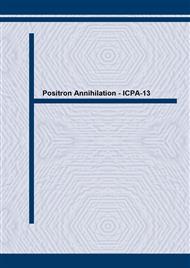[1]
A P Knights and P G Coleman, Defects and Diffusion Forum, Vol. 183 (2000) p.41.
Google Scholar
[2]
P G Coleman, C P Burrows, and A P Knights, Appl. Phys. Lett., Vol. 80 (2002) p.947.
Google Scholar
[3]
The International Technology Roadmap for Semiconductors, Sematech, (2001).
Google Scholar
[4]
S M Sze, Physics of Semiconductor Devices (Wiley, New York 1981).
Google Scholar
[5]
G C Aers, in Positron Beams for Solids and Surfaces, Proceedings of SLOPOS IV (AIP 1991).
Google Scholar
800 0 200 400 600 Junction depth Xj (nm) Chi parameter Figure 3 – Sensitivity plot for � parameter, given by equation (1), versus junction depth. Figure 4 – Experimental plots of S versus E for boron implanted and annealed n-type silicon. Implant energy 2keV-closed squares, 10keV-open diamonds, 25keV-open squares and 2+10keV- closed diamonds. The solid line through the 2keV data is a fit using the four region model described in figure 1.
Google Scholar
[1]
000 0 5 10 15 Incident Energy (keV) S parameter.
Google Scholar


